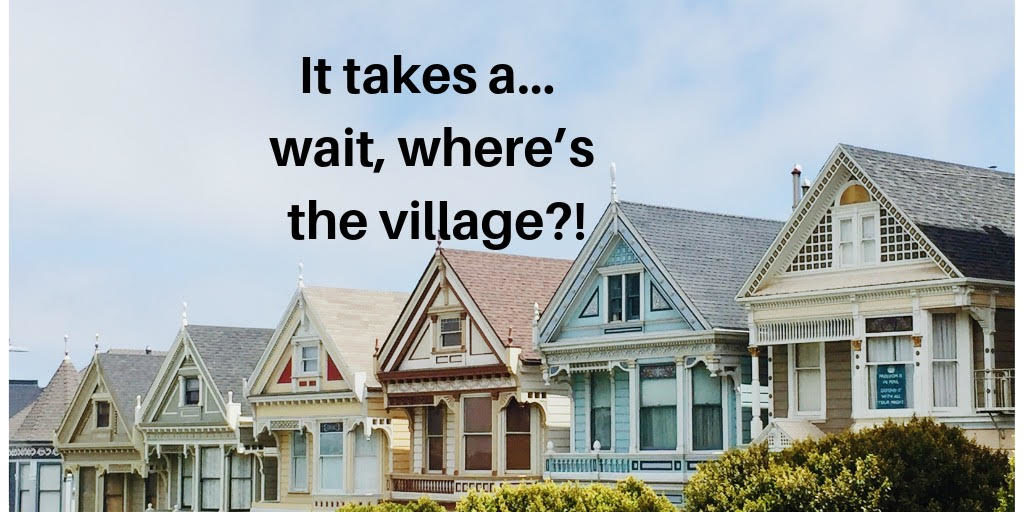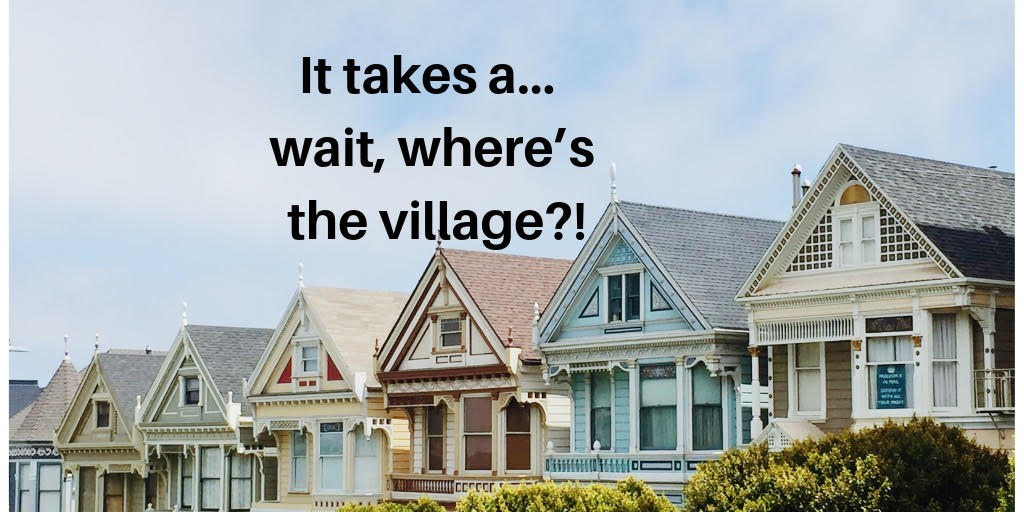A Theology Thursday/ Family Post by the Hobbit and the Elf

We are all familiar with the phrase, “It takes a village to raise a child”. And it’s true isn’t it?! It’s not just some cute proverb that’s stitched on pillows. Not only are we shaped by the events in our lives but also the influences. At every stage in a child’s life- others influences are significant! And parenting? It’s SO difficult! You literally can’t and won’t be the only one impacting your child’s life. And you need help!!!
I don’t want to put too much of a rose tint on my glasses, but it seems like 40 or 50 years ago, families mostly lived close by and churches functioned as a second family. Even if you moved far from your family, someone from church or your kids school would adopt you into their family. Yes, this is a bit of a Norman Rockwell picture. It was not there for everyone, and there were failings in the ways support was provided, but in my experience and observation church family were certainly a bigger part of a child’s life than it tends to be today. And there seems to be a lot more pressure on parents to do and be all, the whole village. Is this simply a cultural shift, or is there more to it than that?
We know that not only has the influence of the church declined but also that the typical family unit spends less time at church than they would have 50 years ago. And we know that there are pros and cons to different ways of doing things liturgically. The decline is a result of a whole bunch of different things and theologians and sociologists have lots of theories on why and how this happened. But we’re going to specifically focus on ‘the village’ aspect of this conundrum. Then we will look at some steps we can take to find the village again.
–The Silo Effect:
The shift to isolating groups and spending less time at church has impacted the role of the village in the church. A significant result of this is that the average evangelical church is several separate churches in one, or siloed churches. There is a children’s church. Only children attend and it is always scheduled to allow the adults to attend their own church. And there is a church for older kids. Sometimes we add in an additional church for young adults. All of these ‘silos’ have a somewhat similar structure – generally labeled as ‘praise and worship’, ‘teaching the lesson’ and ‘small group space’. The small group space set aside for adults during the week becomes their ‘Sunday School Class’. For kids and youth, this is generally (but not always) added as a portion of the kids and youth services.
The important point here is that we really have separate churches operating in the same space but serving completing different constituents on Sunday. So Ms. Betty might not know that little Carl is struggling to read like she might have when they were sitting in the same pew. And Jerry Jr. isn’t going to be reading Scripture during the main service. The isolation breaks up and switches points of connection and interaction. Whereas with, say, a sports team parents and kids are interacting together and separately (and then we wonder why those activities sometimes replace church). Socially, are people comfortable asking the fellow church-goers to be a part of their everyday lives? And then being able to ask for, accept, or offering help to each other? Or do you have to be a part of one of the silos for this to occur? (EG: a member of a small group or Sunday School class)
There has also been a social shift to the home being a silo. Another decline that has been very well documented is our social lives. Even with a greater online connection, we’re missing deeper points of ever day relationships. Very few companies have big picnics and family get-togethers. Gone are the days where you might know your plumber and mailman. Families don’t typically sit on their front porch anymore. Kids aren’t all getting together at the end of the cul-de-sac or at the mall. Teens aren’t going off by themselves as much. There are New York Times articles -like this one– that discuss how our social lives (and really lifelines) have been dramatically fading over the years.
We know that isolation from others messes with out ability to have perspective on other people’s lives. Some would argue this has led to a cultural shift towards fear and anger. Instead of running to our villages for and to give help, it’s much easier to run inside and bolt your doors.
–Going Towards the Grain:
So how do we pop open these ‘silos’ and let others in when it seems to go against the grain of societal expectations? How do we form deep relationships when it’s so much easier to wade in the shallows of acquaintances? We certainly don’t have all the answers. We can’t even wade through all the research. But we do have a few ideas based on how our villages have failed and thrived as well as some others we’ve seen (and read about in stories).
- Know Boundaries and Know Brokeness: It’s important to have boundaries in place for healthy relationships and for a healthy you. Check out Dr. Townsend and Dr. Cloud’s book on this if you need help clarifying what those are. We also have to remember that in all of our stories there is brokenness. No relationship is perfect, but beyond that, no person is perfect. So we should not be expecting perfection or fulfillment from ourselves or others. When we’re able to be authentic and open with ourselves and others it actually helps us develop deeper connections. And we can do that better when we’re seeking our fulfillment from God. It’s important to be able to say ‘no’ to things but it is equally important to know when to say ‘yes’ even when it’s hard. But when we’re filled up with God’s messages of us and about others; it gets a little easier.
Healthy relationships and villages require hard, messy and fun work. - Join a group. Not everyone can be part of a small group/life group/Bible Study group at church, but if you can, try several out. Figure out what works for you and your village. They really can be a lifeline of growth. But joining a group doesn’t stop there. There are other groups to grow with. You can join a workout group, a book discussion group, a sports group- preferably something that gets you out of your comfort zone occasionally and meets in person. Accountability helps keep us track and connected.
- Run Through The Jungle: Get outside! Go to the park. Walk together with others. This is a huge point of connection that used to be a big and fairly common thing. Go camping together! Many years ago we had a group, most all with children, who camped once a month for 9 or so months out of the year. That created such a wonderful community. Stick around for your kids sports team practice and strike up conversations with the other adults. As an introvert, that idea makes me squirm, but I find put myself out there, often great things happen and connections are made.
Connections we make in person bring us out of isolation and we should all probably get outside more anyways. - Online- On Time: Just like we need boundaries in our relationships, we need boundaries for social media. What boundaries do you have set up for your heart and time online? Someone recently challenged me to directly message someone or write a meaningful comment every time I pull up Facebook or Instagram. A daunting task for me, but a good challenge socially. Like in real life, we have to be really intentional about our online connections and relationships.
- Entertainment Adjacent: We consume a boatload of media every day. And I’m not saying you should read our blog more… but you should read our blog more 😉. What media are you consuming? What media is your family consuming? When my kids were teens they used to watch Gilmore Girls at night after practices, and while that show was not something I would ever have chosen to watch on my own I watched it with them. I wanted to be able to talk to them about it and direct their thinking on some of the more adult material. Watching things together, reading together, meme-ing together (is that thing? Haha) can be an incredibly deep point of connection if we delve into it intentionally.
- Last but not least… Serve Somebody. I’m not sure that there is a better way to connect with each other while gaining perspective than serving together. Whether you’re building a set for an elementary musical for free with other volunteers, serving the homeless food, or cheering on racers in a 5K, this is a super important social goal. And it is very important and significant for kids to serve. Studies show it does make a difference when they become adults. I highly suggest this book for kids on ways they can serve. Serving with others is spiritually and socially life giving.
You’re village doesn’t have to be people that are biologically or legally related to you, it doesn’t have to be people that you do something for or with. Our villages are the people that we build deep connections with. They are the ones we want influencing us and our kids. So let’s take steps towards that even though the way is sticky. Because it’s vital that we have a support systems for ourselves and our families. Jesus gave us so many examples of what this can look like. We all fall, we all have successes to share and a lot of funny and mundane moments that we don’t need to do alone. Hallelujah.

Down The Hobbit Hole Blog uses affiliate links, we only link products we think you’ll like and you are never charged extra for them. As Amazon Associates, we earn from qualifying purchases at no additional cost to you. We also use cookies to gather analytics and present advertisements. This allows us to keep writing discussion questions and telling ridiculous dad jokes. Find our other reviews with discussion questions here. Our posts about faith here. And our posts about family stuff here.
